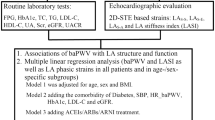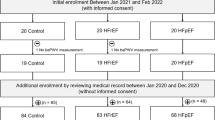Abstract
Data regarding the influence of arterial stiffness on left ventricular (LV) long-axis function has been scarce. This study was performed to investigate the association between brachial-ankle pulse wave velocity (baPWV) and LV global longitudinal strain (GLS). A total of 248 subjects (mean age 59.2 ± 12.3 years; 50 % were men) without structural heart problems were retrospectively evaluated. LV GLS was measured by 2-dimensional speckle-tracking echocardiography. baPWV measurements were made on the same day of echocardiography. The incidences of hypertension, diabetes mellitus, and dyslipidemia were 51.2, 19.4, and 22.2 %, respectively. The mean value of baPWV was 1557 ± 285 cm/s. In simple linear regression analysis, baPWV had a significant positive association with LV GLS (β = 0.215, P = 0.001). In multiple linear regression analysis, baPWV was independently associated with LV GLS even after controlling for potential confounders, including age, gender, body mass index, systolic blood pressure, heart rate, HbA1c, total cholesterol, estimated glomerular filtration rate, left ventricular mass index, E/A, septal e′ velocity and pulmonary artery systolic pressure (β = 0.211, P = 0.028). The results of this study suggest that baPWV may be independently associated with LV GLS, supporting the evidence of a close interaction between arterial stiffness and LV function. Increased arterial stiffness may result in impaired LV longitudinal function.

Similar content being viewed by others
References
Lee HY, Oh BH (2010) Aging and arterial stiffness. Circ J 74:2257–2262
Cavalcante JL, Lima JA, Redheuil A, Al-Mallah MH (2011) Aortic stiffness: current understanding and future directions. J Am Coll Cardiol 57:1511–1522
Vlachopoulos C, Aznaouridis K, Stefanadis C (2010) Prediction of cardiovascular events and all-cause mortality with arterial stiffness: a systematic review and meta-analysis. J Am Coll Cardiol 55:1318–1327
van Sloten TT, Schram MT, van den Hurk K, Dekker JM, Nijpels G, Henry RM et al (2014) Local stiffness of the carotid and femoral artery is associated with incident cardiovascular events and all-cause mortality: the Hoorn study. J Am Coll Cardiol 63:1739–1747
Munakata M (2014) Brachial-ankle pulse wave velocity in the measurement of arterial stiffness: recent evidence and clinical applications. Curr Hypertens Rev 10:49–57
Kim HL, Im MS, Seo JB, Chung WY, Kim SH, Kim MA et al (2013) The association between arterial stiffness and left ventricular filling pressure in an apparently healthy Korean population. Cardiovasc Ultrasound 11:2
Wu N, Cai X, Ye K, Li Y, He M, Zhao W et al (2014) Association between brachial-ankle pulse wave velocity and cardiac autonomic neuropathy in type 2 diabetes. Diabetol Metab Syndr 6:82
Ki YJ, Choi DH, Lee YM, Lim L, Song H, Koh YY (2014) Predictive value of brachial-ankle pulse wave velocity for long-term clinical outcomes after percutaneous coronary intervention in a Korean cohort. Int J Cardiol 175:554–559
Kim J, Song TJ, Kim EH, Lee KJ, Lee HS, Nam CM et al (2014) Brachial-ankle pulse wave velocity for predicting functional outcome in acute stroke. Stroke 45:2305–2310
Vlachopoulos C, Aznaouridis K, Terentes-Printzios D, Ioakeimidis N, Stefanadis C (2012) Prediction of cardiovascular events and all-cause mortality with brachial-ankle elasticity index: a systematic review and meta-analysis. Hypertens 60:556–562
Blessberger H, Binder T (2010) Non-invasive imaging: two dimensional speckle tracking echocardiography: basic principles. Heart 96:716–722
Pavlopoulos H, Nihoyannopoulos P (2008) Strain and strain rate deformation parameters: from tissue Doppler to 2D speckle tracking. Int J Cardiovasc Imaging 24:479–491
Antonini-Canterin F, Carerj S, Di Bello V, Di Salvo G, La Carrubba S, Vriz O et al (2009) Arterial stiffness and ventricular stiffness: a couple of diseases or a coupling disease? A review from the cardiologist’s point of view. Eur J Echocardiogr 10:36–43
Yambe M, Tomiyama H, Hirayama Y, Gulniza Z, Takata Y, Koji Y et al (2004) Arterial stiffening as a possible risk factor for both atherosclerosis and diastolic heart failure. Hypertens Res 27:625–631
Mottram PM, Haluska BA, Leano R, Carlier S, Case C, Marwick TH (2005) Relation of arterial stiffness to diastolic dysfunction in hypertensive heart disease. Heart 91:1551–1556
Eren M, Gorgulu S, Uslu N, Celik S, Dagdeviren B, Tezel T (2004) Relation between aortic stiffness and left ventricular diastolic function in patients with hypertension, diabetes, or both. Heart 90:37–43
Patrianakos AP, Parthenakis FI, Karakitsos D, De Groot E, Skalidis EA, Nyktari E et al (2007) Relation of proximal aorta stiffness to left ventricular diastolic function in patients with end-stage renal disease. J Am Soc Echocardiogr 20:314–323
Kass DA (2005) Ventricular arterial stiffening: integrating the pathophysiology. Hypertens 46:185–193
Lee CS, Cha RH, Lim YH, Kim H, Song KH, Gu N et al (2010) Ethnic coefficients for glomerular filtration rate estimation by the Modification of Diet in Renal Disease study equations in the Korean population. J Korean Med Sci 25:1616–1625
Lang RM, Badano LP, Mor-Avi V, Afilalo J, Armstrong A, Ernande L et al (2015) Recommendations for cardiac chamber quantification by echocardiography in adults: an update from the american society of echocardiography and the European association of cardiovascular imaging. J Am Soc Echocardiogr 28(1–39):e14
Taaffe DR, Cauley JA, Danielson M, Nevitt MC, Lang TF, Bauer DC et al (2001) Race and sex effects on the association between muscle strength, soft tissue, and bone mineral density in healthy elders: the Health, Aging, and Body Composition Study. J Bone Miner Res 16:1343–1352
Smith A, Karalliedde J, De Angelis L, Goldsmith D, Viberti G (2005) Aortic pulse wave velocity and albuminuria in patients with type 2 diabetes. J Am Soc Nephrol 16:1069–1075
Fernandes VR, Polak JF, Cheng S, Rosen BD, Carvalho B, Nasir K et al (2008) Arterial stiffness is associated with regional ventricular systolic and diastolic dysfunction: the Multi-Ethnic Study of Atherosclerosis. Arterioscler Thromb Vasc Biol 28:194–201
van Schinkel LD, Auger D, van Elderen SG, Ajmone Marsan N, Delgado V, Lamb HJ et al (2013) Aortic stiffness is related to left ventricular diastolic function in patients with diabetes mellitus type 1: assessment with MRI and speckle tracking strain analysis. Int J Cardiovasc Imaging 29:633–641
Hwang JW, Kang SJ, Lim HS, Choi BJ, Choi SY, Hwang GS et al (2012) Impact of arterial stiffness on regional myocardial function assessed by speckle tracking echocardiography in patients with hypertension. J Cardiovasc Ultrasound 20:90–96
Vinereanu D, Nicolaides E, Boden L, Payne N, Jones CJ, Fraser AG (2003) Conduit arterial stiffness is associated with impaired left ventricular subendocardial function. Heart 89:449–450
Roman MJ, Ganau A, Saba PS, Pini R, Pickering TG, Devereux RB (2000) Impact of arterial stiffening on left ventricular structure. Hypertens 36:489–494
Lee SP, Kim YJ, Kim JH, Park K, Kim KH, Kim HK et al (2011) Deterioration of myocardial function in paradoxical low-flow severe aortic stenosis: two-dimensional strain analysis. J Am Soc Echocardiogr 24:976–983
Donal E, Bergerot C, Thibault H, Ernande L, Loufoua J, Augeul L et al (2009) Influence of afterload on left ventricular radial and longitudinal systolic functions: a two-dimensional strain imaging study. Eur J Echocardiogr 10:914–921
Baltabaeva A, Marciniak M, Bijnens B, Moggridge J, He FJ, Antonios TF et al (2008) Regional left ventricular deformation and geometry analysis provides insights in myocardial remodelling in mild to moderate hypertension. Eur J Echocardiogr 9:501–508
Abraham TP, Dimaano VL, Liang HY (2007) Role of tissue Doppler and strain echocardiography in current clinical practice. Circulation 116:2597–2609
Nagueh SF, Appleton CP, Gillebert TC, Marino PN, Oh JK, Smiseth OA et al (2009) Recommendations for the evaluation of left ventricular diastolic function by echocardiography. J Am Soc Echocardiogr 22:107–133
Sato K, Seo Y, Ishizu T, Takeuchi M, Izumo M, Suzuki K et al (2014) Prognostic value of global longitudinal strain in paradoxical low-flow, low-gradient severe aortic stenosis with preserved ejection fraction. Circ J 78:2750–2759
Cho GY, Marwick TH, Kim HS, Kim MK, Hong KS, Oh DJ (2009) Global 2-dimensional strain as a new prognosticator in patients with heart failure. J Am Coll Cardiol 54:618–624
Fang ZY, Leano R, Marwick TH (2004) Relationship between longitudinal and radial contractility in subclinical diabetic heart disease. Clin Sci 106:53–60
Acknowledgments
The authors appreciate the help of Seon Kyung Lee, Min-Seon Choi, Yu Nui Gim, and Hye Jin Park with data collection.
Author information
Authors and Affiliations
Corresponding author
Ethics declarations
Conflict of interest
The authors have no conflicts of interest.
Ethical approval
All procedures performed in studies involving human participants were in accordance with the ethical standards of the Institutional Review Board of Boramae Medical Center (Seoul, Korea) with the 2008 Helsinki declaration.
Informed consent
Informed consent was waived by Institutional Review Board of Boramae Medical Center (Seoul, Korea) due to retrospective study design.
Rights and permissions
About this article
Cite this article
Kim, HL., Seo, JB., Chung, WY. et al. Independent association between brachial-ankle pulse wave velocity and global longitudinal strain of left ventricle. Int J Cardiovasc Imaging 31, 1563–1570 (2015). https://doi.org/10.1007/s10554-015-0744-5
Received:
Accepted:
Published:
Issue Date:
DOI: https://doi.org/10.1007/s10554-015-0744-5




